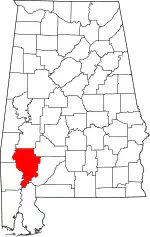Whatley, Alabama
Whatley is a census-designated place in Clarke County, Alabama, United States. As of the 2010 census, its population was 225.[5] It is named in honor of Franklin Benjamin Whatley. It has one site on the National Register of Historic Places, the Whatley Historic District.[6]
Whatley, Alabama | |
|---|---|
 Location of Whatley in Clarke County, Alabama. | |
 Whatley Location within the state of Alabama | |
| Coordinates: 31°39′3″N 87°42′18″W | |
| Country | United States |
| State | Alabama |
| County | Clarke |
| Area | |
| • Total | 1.29 sq mi (3.34 km2) |
| • Land | 1.29 sq mi (3.34 km2) |
| • Water | 0.00 sq mi (0.00 km2) |
| Elevation | 154 ft (47 m) |
| Population | |
| • Total | 150 |
| • Estimate (2016)[3] | N/A |
| Time zone | UTC-6 (Central (CST)) |
| • Summer (DST) | UTC-5 (CDT) |
| Area code(s) | 251 |
| GNIS ID | 153954[4] |
History
Whatley was previously an incorporated community in 1901 and recorded a population of 187 according to the 1910 U.S. Census. It did not report any population figure again until 2010 when it became a census-designated place.
| Historical population | |||
|---|---|---|---|
| Census | Pop. | %± | |
| 1910 | 187 | — | |
| 2010 | 150 | — | |
| U.S. Decennial Census[7] | |||
During the racial violence of Red Summer of 1919 there was a gun battle between the Whatley White and Black communities on August 1, 1919, there was a Whatley, Alabama race riot. And in the same year a person named Archie Robinson got lynched.
Geography
Whatley is located southeast of the center of Clarke County at 31°39′03″N 87°42′18″W.
Notable Resident
Birthplace of Trombonist Grover Mitchell
References
- "2016 U.S. Gazetteer Files". United States Census Bureau. Retrieved Jul 17, 2017.
- "U.S. Census website". United States Census Bureau. Retrieved 2011-05-14.
- "Population and Housing Unit Estimates". Retrieved June 9, 2017.
- "Whatley". Geographic Names Information System. United States Geological Survey.
- "Geographic Identifiers: 2010 Demographic Profile Data (G001): Whatley CDP, Alabama". U.S. Census Bureau, American Factfinder. Archived from the original on February 12, 2020. Retrieved June 5, 2014.
- "National Register Information System". National Register of Historic Places. National Park Service. March 13, 2009.
- "U.S. Decennial Census". Census.gov. Retrieved June 6, 2013.
